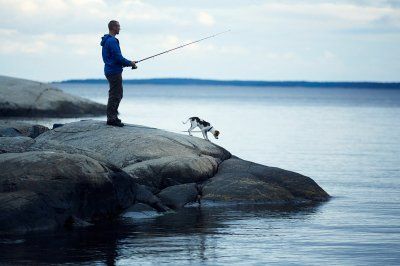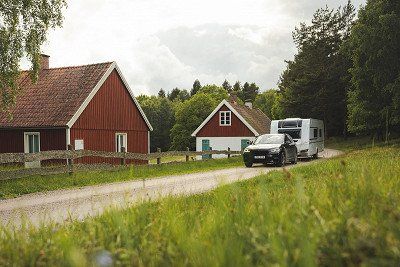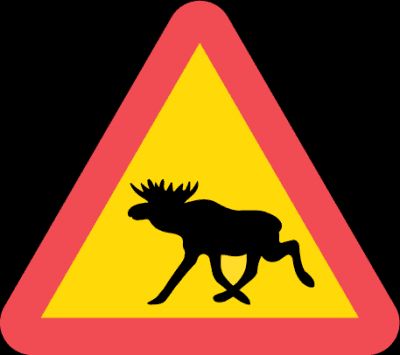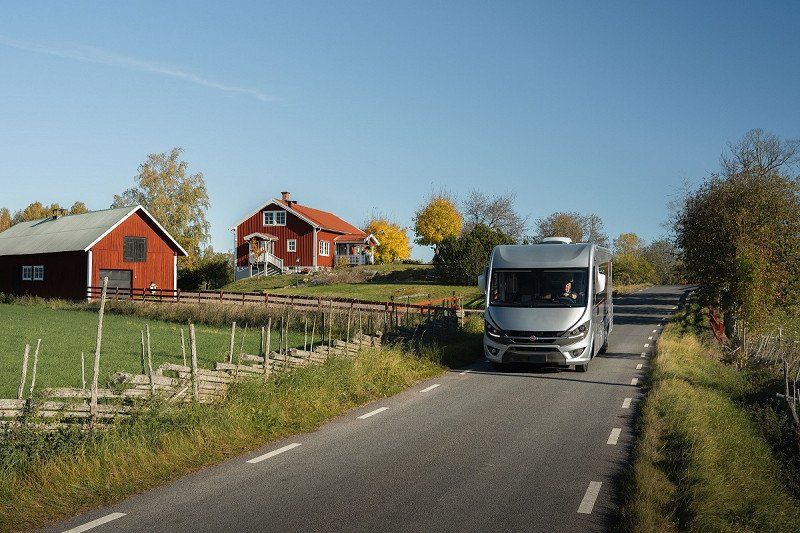Last update: April 7, 2025
Contents
Travelling to Sweden
The main traffic rules for motorhomes and caravans in Sweden
Information about the toll in Sweden
Petrol stations - opening times and means of payment in Sweden
General traffic rules in Sweden
Rent a motorhome in Sweden
Important addresses and telephone numbers for holiday makers in Sweden
Travelling to Sweden
Entry requirements for European citizens: For a tourist stay, European citizens need a passport or an identity card or a children's passport, which is valid until the end of the stay. Temporary identification documents are also accepted.
Entry of children into Sweden: There are no special regulations for the entry of minors. For the sake of simplicity, minors travelling without a legal guardian should carry a certified declaration of consent from a parent or guardian.

Travelling to Sweden with pets: Pets such as dogs, cats and ferrets must meet the following requirements in order to enter Sweden: They must be at least 12 weeks old. They also need an EU pet passport as well as a microchip identification and a valid rabies vaccination. The vaccination must be carried out in accordance with the recommendations of the vaccine manufacturer. It needs to be documented and carried out at least 21 days before entering Sweden, provided that the basic vaccination is involved. You don't have to wait 21 days for booster vaccinations. A tattoo to identify the animal is only permitted if it was done before July 3, 2011. The previously mandatory blood tests and worm therapies are no longer necessary - but regular worm therapies are still recommended. Pets traveling with you should also officially be registered with Swedish customs - this can also be done online in advance. The following video explains the entry requirements again:
Video: What do dog and cat owners have to consider before entering Sweden?
Further rules for dog owners in Sweden
- Between March 1st and August 20th it is mandatory to keep your dog on a leash on forest and field paths in order to protect wild animals. Even outside of this time it is often common in Sweden for dogs to be on a leash in the wild. This often also applies to many cities and campsites.
- Dogs are often not allowed on official beaches and bathing areas. There are usually special dog beaches or alternative beaches in the vicinity where the four-legged friends can let off steam and cool off.
- Dog waste must also be disposed of by the owner.
- In Sweden dogs are sometimes not allowed to go into the restaurant - it is best to ask before you order a table.

The main traffic rules for motorhomes and caravans in Sweden
In general, there are no generally applicable speed regulations or recommended speeds on Swedish roads - the current signs in the respective areas always apply. But there are certain base values that can be used to guide you, whereby there is an increasing trend towards speed limits with straight numbers. These include, for example, speed limits of 40 km/h within built-up areas and 80 km/h outside built-up areas. The following table serves as a orientation guide:
Attention: There are no tolerance limits in Sweden for exceeding speed limits. Penalties are significantly higher than in some other European countries.
Information about the toll in Sweden
The good news for holiday makers in Sweden: In Sweden there is no general toll on motorways or on country roads. However, in the two major cities of Stockholm and Gothenburg there is an inner city toll that also applies to cars, trucks and buses up to 14 t registered abroad - including motorhomes and caravan teams. The so-called Essingeleden, Stockholm's inner city bypass, is also subject to tolls.
Unlike in other European countries, there are no toll stations in Sweden where you have to stop and no transponder is required. Instead, the license plates of the vehicles are automatically recorded by camera as they drive through the checkpoints called Betalstation. The vehicle owner will then receive the invoice at home by post via the company Epass24. Caution: Invoices that are not paid by the stated payment deadline always incur an additional penalty fee of SEK 500. It is therefore always advisable to register your vehicle online with Epass24 before travelling to Sweden (and also Norway) and to pay outstanding tolls automatically by credit card or direct debit. If you are travelling with a rental vehicle, you can and should enter the corresponding rental period in your account with Epass24.

How much does the city toll cost in Stockholm and Gothenburg?
The city toll is a kind of traffic jam fee and is therefore different depending on the day of the week and the time of day as well as the season of the year. No fees are charged on Saturdays, Sundays, the day before a public holidays and the public holiday itself as well as in the month of July (exception Stockholm: the first five working days of the month July are subject to tolls). The same applies daily for the time between 6:30 p.m. and 5:59 a.m. the following day. Different charges apply between 6:00 a.m. and 6:29 p.m.: they are highest during traditional rush hour traffic and lowest between 9:30 a.m. and 2:59 p.m. In Stockholm the lowest fare is 11 SEK, in Gothenburg it is 9 SEK. The maximum amount per day per vehicle is SEK 60 in Gothenburg, in Stockholm, a maximum of SEK 45 is charged each way (prices as of April 2025). The category of the respective vehicle does not matter.
By the way: In Gothenburg the one-time fee rule applies: if you pass several checkpoints within 60 minutes, you only have to pay one fee. The highest tariff applicable for the transit will be charged.
Tip: There is a very well developed network for public transport in both Stockholm and Gothenburg. Ideally, you should look for a campsite, motorhome site or Park & Ride parking space outside the city centers and travel into the city by bus, train or bike.

Bridge toll in Sweden
There are currently four bridges in Sweden where a toll is charged for using them. The most famous of these is certainly the impressive Öresund Bridge, which connects Sweden with Denmark. It runs from Malmö-Lernacken in Sweden to Copenhagen-Kastrup in Denmark. The tariffs depend on the type of vehicle and the length of the vehicle. Motorhomes are charged according to the total length in the categories from 6 m and from 10 m. For caravan combinations, the prices are based on the length of the trailer up to 15 m and from 15 m and on the length of the towing vehicle under 6 m and over 6 m respectively. The crossing of the Öresund Bridge costs for cars, caravans and motorhomes up to 10 meters between about 61 euros and 123 euros per one-way trip without a so called ØresundGO subscription (prices as of April 2025). The fees are paid on site in cash or by credit card. But there is also the option of buying an online ticket in advance, which comes a little cheaper.
The use of the bridges in Sundsvall and Motala is also chargeable. Since October 2023 the infrastructure charge is also levied on the new Skurubron (Skuru Bridge), which crosses Skurusund southeast of Stockholm. But there are no toll stations here. Similar to the city toll in Stockholm and Gothenburg, the fees for using these bridges are levied through the automatic registration of the vehicle registration number via Epass24. The invoice will be sent by post or paid automatically when the licence plate is registered with Epass24.


Petrol stations - opening times and means of payment in Sweden
In Sweden there is a well-developed network of petrol stations, which, however, becomes increasingly thinner the further north you travel. For this reason, you are allowed to carry a reserve canister with up to 30 liters of fuel within Sweden. Almost all petrol stations are self-service and are open seven days a week, some even around the clock.
Manned petrol stations are increasingly becoming the exception in Sweden, instead there are more and more petrol terminals where you have to pay with credit card and PIN code. Most of the time, MasterCard and Visa cards are accepted. There are also petrol terminals where you can pay with Swedish banknotes (Sedel). However, these are becoming increasingly rare in Sweden.

General traffic rules in Sweden
Compulsory daytime running lights: In Sweden there is a light requirement all year round at all times - even in summer under the light of the midnight sun. So always remember to turn on your headlamps or daytime running lights. The light requirement also applies to trailers, including the rear lighting of the caravan.
Drink-drive limit: The blood alcohol limit in Sweden is 0.2 ‰. Anyone who “can no longer safely drive a vehicle” under the influence of alcohol or narcotics can also be convicted of drunkenness. There are high penalties in the event of a violation - including prison sentences of up to two years or driving license revocation.
Child safety car seats: Children under 1.35 m need a child safety seat that is suitable for the weight and height of the child. Anyone driving with a child on the front passenger seat in a rear-facing child seat must deactivate the airbag.
Talking on the phone while driving: The mobile phone may only be used in the vehicle with a hands-free device for telephone calls and for navigation. It is expressly prohibited to use any communication devices that you hold in your hand.

Compulsory Winter tyres: In winter road conditions, both cars, motorhomes, and caravans must be equipped with winter tyres that carry the Alpine symbol. Tyres with M+S marking are nowadays only accepted for trailers until 2028. In any case the minimum tread depth for vehicles and trailers up to 3.5 tonnes total weight is 3 mm. Alternatively, snow chains or studded tyres are permitted. Motor vehicles and trailers over 3.5 t must be fitted with winter tyres on all wheels from 1 December to 31 March. The minimum tread depth for these tyres is 5 mm. In addition, every driver is required to carry anti-freeze and a snow shovel. Snow chains or spikes can also be used if necessary.
Marking of protruding cargo: protruding load (such as bike racks) may protrude a maximum of 1 m at the front and rear and a maximum of 20 cm at the sides. If the load exceeds these dimensions, it must be marked. During the day a conspicuous cloth or flag is sufficient, in the dark a white light and white reflectors must be attached to the front and a red light and red reflectors to the rear. Including the load, a vehicle may not be wider than 2.60 m and not longer than 13 m.

Beware of moose crossing: There is hardly a visitor to Sweden who would not like to see at least one moose in the wild during his stay. However, this should not be while driving and being on the road. Because even if the moose population in Sweden has decreased in the past decade, accidents with elk are not uncommon. This is especially true in the time between dusk and dawn. Therefore, you should definitely take the moose warning signs on the roadside seriously and take a little off the accelerator.
A collision with a full-grown moose can have bad consequences for everyone involved, as the animal's weight and increased center of gravity are very unfavorable, especially for cars. For this reason you should always try to avoid a moose. Any collision with an elk or a larger animal such as deer, reindeer, wild boar, bear, wolf, lynx or the like must be reported to the police immediately, even if the animal was not injured or killed. The scene of the accident must be marked. This is not necessary for smaller animals such as badgers, rabbits or foxes.
Rent a motorhome in Sweden
For all those who do not have their own motorhome, only have limited time for the Sweden tour or want to save themselves the journey to Sweden, it is worth renting a motorhome or campervan locally. The two motorhome rental companies rent easy and McRent are ideal for this, both of which operate several rental stations in Sweden and also offer discounted rates for Freeontour members. If you want to explore the southern parts or the centre of Sweden, you can fly directly to Stockholm or Gothenburg, for example, and change into a motorhome or campervan there. Those who are drawn to the north of Sweden to Swedish Lapland under the light of the midnight sun can fly directly to Umeå or Luleå.
Important addresses and telephone numbers for holiday makers in Sweden
European emergency number: 112
You can get help from the local police, fire brigade, emergency doctor or ambulance via this central emergency number, which can be reached free of charge via landline or mobile phone without a dialing code.




